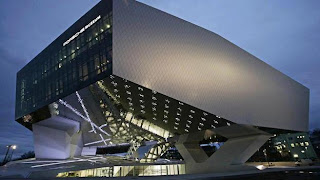Porsche’s secret stash
Crouched down behind the car you see above, I'm stumped. I have the nagging feeling I've seen this clip somewhere before, but right now I can't place it.
It's not a regular car part, though. Ah, got it, it's the front clamp from an old wire ski binding - don't ask me how I know this, but I'm fairly sure no one else here can identify it.
"Do you know what this is?" comes a voice at my shoulder. I stand up, ready to reveal my disturbingly in-depth knowledge of ancient ski equipment, but before I can fix my features to smug, he continues, "It's from an old ski binding. The engineers were having difficulty holding the engine cover of the 910 down safely, and, over dinner one night, Mr Piëch spoke about this to his good friend Mr Geze, whose firm made these bindings, and this was the solution."
Dieter Landenberger is manager of Porsche's archives and a man who probably knows more about Porsche's history and heritage than the Porsche family themselves. This is fortuitous, as I'm currently in a warehouse containing many curious Porsches, most of which I'm struggling to identify. There is a reason I'm here. Porsche has a museum (if you haven't been and happen to find yourself in Stuttgart, go. It's amazing. Especially the escalator) but the 80 cars there are just the tip of a 500-strong iceberg. All of which have to be stored somewhere.
This is the somewhere. It's not far from the museum, just another industrial building in an industrial corner of an industrial city. It used to house a production line, but will soon store an entire back catalogue of automotive greatness (and not-so-greatness). I say soon because the ink on the lease is still wet. That's right, TopGear is here to help Porsche move its family jewels into a new home. Let's hope its insurance policy is up to date.
Big shiny trucks arrive, doors are opened, glimpses of cars appear and ramps are lowered. A man jumps on to a bright red Porsche tractor of considerable vintage and concours condition. There's a typically agricultural noise accompanied by a localised and particularly noxious fog cloud. When it clears, the tractor is revealed to be towing a totally see-through Cayenne Hybrid out from the transporter's interior. If Porsche were really concerned about CO2 emissions, this would surely be happening the other way round...
I lend a hand and loosen the ratchet strap on a Type 597 Jagdwagen military jeep. It lurches backwards, at which point some German expletives occur and I realise that old cars don't necessarily have effective handbrakes. Nor are they in perfect nick. Some are decidedly moth-eaten in fact, like the battered 906 that seems to have crashed headlong through each and every one of the 46 intervening years.
It looks properly battle scarred, all peeling bonnet badge, shagged upholstery and rotting composite panels. It's possibly my favourite car in the whole place, a story behind each ding and wrinkle. Dieter looks it over sympathetically and says: "It would be a shame to over-restore this car, we want to keep the authenticity of these cars alive. That, for us, is a big challenge."
I'm glad to hear him say it. Glad, too, that most of these cars are in less than pristine condition. The majority smell musty inside, dust is evident, they look like they've lived a bit. Or at least been in storage for a while. They jar with the polished floor and fresh paint that's been daubed around here. But this facility is evidence of how seriously Porsche takes its back catalogue. This, surprisingly, is a relatively recent phenomenon. The firm only started keeping the first and last cars from each production run a few years back. It's now making up for lost time by going on the open market and buying important cars back. It recently got hold of a 993 Cabrio. From Julio Iglesias. Yeah.





No comments:
Post a Comment